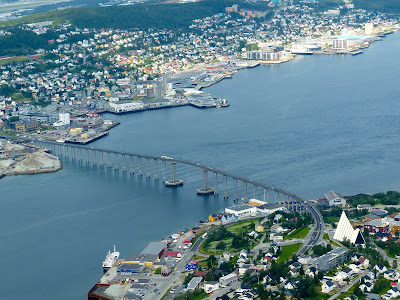 |
| view from the Oslo to Bergen train |
Built between 1875 and 1909 the Bergen Line climbs to 1200m and takes six and a half hours, during which it goes through 182 tunnels!
 |
| view from the Oslo to Bergen train |
The highest station, Finse, is at 1222m and the line climbs up to 1237m when it crosses the desolate
Hardangervidda plateau, making it the highest mainline railway line in Northern Europe.
 |
| view from the Oslo to Bergen train |
 |
| view from the Oslo to Bergen train |
 |
| our Oslo to Bergen train, on arrival in Bergen station |
Located on the west coast of Norway, Bergen is the same latitude as
Oslo (≈60°N) but we found it quite a bit cooler! Norway's second-largest city is well-known for its wooden gabled buildings at
Bryggen waterfront, a UNESCO World Heritage site since 1979 (Bryggen means 'the dock').
 |
| Bergen's centrepiece: Bryggen waterfront |
Bryggen currently comprises 58 buildings which date from the early 18th century, although the building pattern is 12th century.
 |
| close-up of one of the wharf buildings |
We also visited
Bergenhus fortress which contains a number of buildings including Rosenkrantz Tower and
Haakon's Hall - the latter is the largest secular medieval building in Norway.
 |
| Håkonshallen |
 |
| street in the Stølen neighbourhood of Bergen |
On our second morning we visited
Old Bergen open-air museum which lets you experience the atmosphere from a time when Bergen was Europe’s biggest wooden city.
 |
| historical reenactment at Gamle Bergen museum |
We then hiked up Stoltzekleiven, a steep (315 metres elevation) paved trail with 801 steps that leads up to
Sandviksfjellet, one of Bergen's
seven 'mountains'; the city has been compared to
Rome for this reason. Coming from
Reunion, I call them hills as the highest,
Ulriken, is only 643 metres above sea level!
 |
| part of the Stoltzekleiven path |
 |
| from the top we had great views over Bergen's fjords |
 |
| wagtail |
To get back down we took the funicular from Fløyen.
 |
| Fløibanen funicular |
We hired a car for the next two days (eyewateringly expensive to do in Norway!), and on the first day headed inland to the Western fjords.
We parked our car at Gudvangen, took a bus to
Flåm, and from there went on a two-hour cruise through
Aurlandsfjord and
Nærøyfjord. The latter is a beautiful 17km-long UNESCO World Heritage site fjord, surrounded by towering cliffs 1200m high.
 |
| Nærøyfjord |
 |
| in Aurlandsfjord |
 |
| in Nærøyfjord |
 |
| Nærøyfjord |
 |
| village of Bakka: four farms and ten inhabitants |
When we returned to our car we drove along the road beside the fjord back to Bakka and were stopped by a (Shetland?) pony who wouldn't budge from the middle of the road!
 |
| traffic jam near Bakka! |
 |
| Highland cow near Bakka |
On our way back we stopped at Stalheim Hotel which is located high above the Nærøydalen valley and has fantastic views.
 |
| at Stalheim |
 |
| view from Stalheim |
 |
| view looking down Nærøydalen valley from Stalheim |
 |
| Sivlefossen waterfall |
For our final day we explored the
Hardangerfjord area: classic Norwegian fjord country. At 179 km long the fjord itself is the fourth longest in the world, and stretches from the sea south of Bergen to the mountainous interior of Norway along the Hardangervidda plateau.
 |
| waterfall in the Hardangerfjord area |
Steinsdalsfossen waterfall is one of the most visited tourist sites in Norway. The waterfall is only 50 or so metres high, but you can walk behind it while staying dry.
 |
| view from behind Steinsdalsfossen |
 |
| view looking across Steinsdalsfossen |
While driving around this area we had several views of the
Folgefonna ice field - the third largest in Norway, with three glaciers covering 168 km2 and ice up to 400 m thick in places.
 |
| a view of Folgefonna |
By the way, all the bus stops we saw in the Norwegian countryside had grass-covered roofs, sometimes even bin shelters had grass roofs too!
 |
| countryside bus stop |
See also:












































































